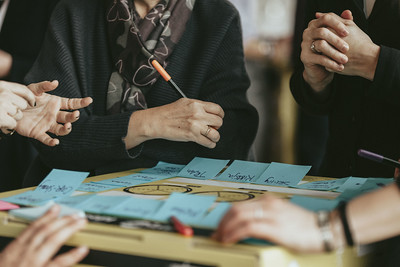Co-design
Also known as: Co-creation, policy transfer, collaborative process
Co-design is a collaborative method of coming up with solutions to common challenges. Beginning with a best practice in a domain of common interest, participants work in groups through a series of guiding questions. They pair back or augment the practice to create a solution that harvests the basic idea of the initial best practice but could be widely applicable in multiple contexts.
Method
- Identify shared topic of interest: The topic of interest can be identified either before the co-design process begins, with interested parties selected afterwards, or it can be defined by a pre-identified group on the basis of common concerns.
- Identify tangible solutions: Members or participants initially share and submit their tangible solutions in a designated online space.
- Selection of best practice: From the shared solutions, members choose a good practice that seems promising and has the potential for wider application.
- Understanding the best practice:
- Distribute relevant documents and media concerning the best practice.
- Facilitate online discussions for participants to delve deep into understanding the selected best practice and the local contexts it can be applied in.
- Define common needs: Once a clear understanding is developed, the participants collaboratively define their collective needs and requirements.
- Develop common solution:
- Use the chosen best practice as a foundation.
- Conduct both online and in-person meetings, integrating design thinking workshops, rapid prototyping, and testing and validation sessions.
- Develop a common solution that meets the defined needs.
- Publish results: After developing the common solution, publish and share the outcomes so that a broader audience or similar entities can benefit.
- Implement and iterate:
- Begin the implementation of the developed solution in the participants’ individual contexts.
- Monitor the application of the solution and facilitate ongoing discussions for continuous iterative improvement.

Examples of application
Eurocities’ Digital Forum Lab
-
- Identification: Members shared tangible solutions in an online platform.
- Selection: From the shared solutions, good practices were chosen for the co-creation of a common solution suitable for multiple European cities.
- Understanding: Relevant documents and media were circulated, and online discussions were facilitated.
- Development: Design thinking workshops, rapid prototyping, and testing/validation sessions were employed to shape a common solution.
- Publication: Once developed, the results were made public for other cities to benefit.
- Implementation: Cities began integrating the solution in their local contexts, with ongoing monitoring and discussions for enhancement.
Eurocities’ EU-funded Fast Track project:
-
-
- Workshops: Participants were gathered and presented with a real goal and the associated challenges faced by a certain city.
- Solution brainstorming: Participants worked in groups to brainstorm solutions for the presented challenge.
- Actionable solutions: The aim was to develop solutions that cities could take back and implement to address the identified goal and challenge.
-
Top tips
For in-person workshops canvases should be developed to guide the discussion. A clear link between the canvas and the deployment plan cities need to develop was made to allow cities to use the on-site workshop time as efficiently as possible.
Structuring the inputs and outputs and collaboration using tools like Miro, Mural and SharePoint works very well.
Pros & cons
Pros
- Co-design engages members around a specific topic and solution. It creates a basis for long-term commitment and collaboration.
- It is a great way to share knowledge extensively and effectively on a specific topic and solution.
Cons
- Working on technical solutions can prove difficult with participants that do not have a technical background.
- A predefined process and structure for collaboration with multiple people from multiple cities proves difficult sometimes, as it is a way of working that some are not used to. This means additional time to train participants and be flexible in application of the predefined approach, which in turn may undermine the approach itself.
Outcomes and impact
Co-design results in creative solutions to pre-defined challenges. It also leads to stronger bonds between participants going forward.
Impact
In the CIVITAS FastTrack project, cities co-designed citizen engagement strategies. With the help of peer cities Groningen, Tampere, Budapest and Kadikoy, representatives from Debrecen went home with a clear concept on how to engage with their citizens for the development of a network of micro-mobility stations to complement their public transport service.
Pitfalls
You may have some participants that are more willing to collaborate than others. You can counter this by being careful in the selection of candidates, and by using structured collaboration tools.
Links
A capacity building handbook from our FastTrack project


